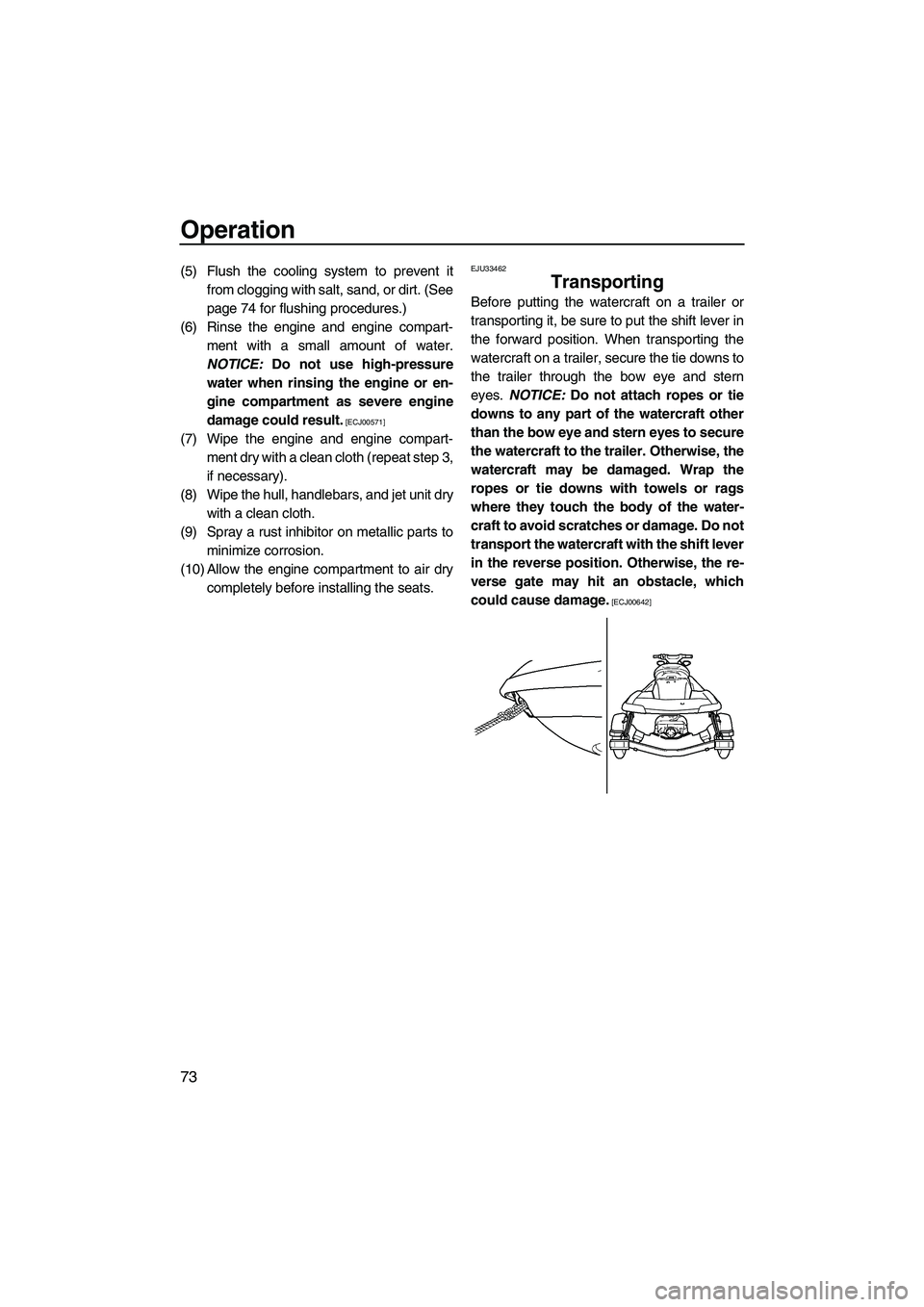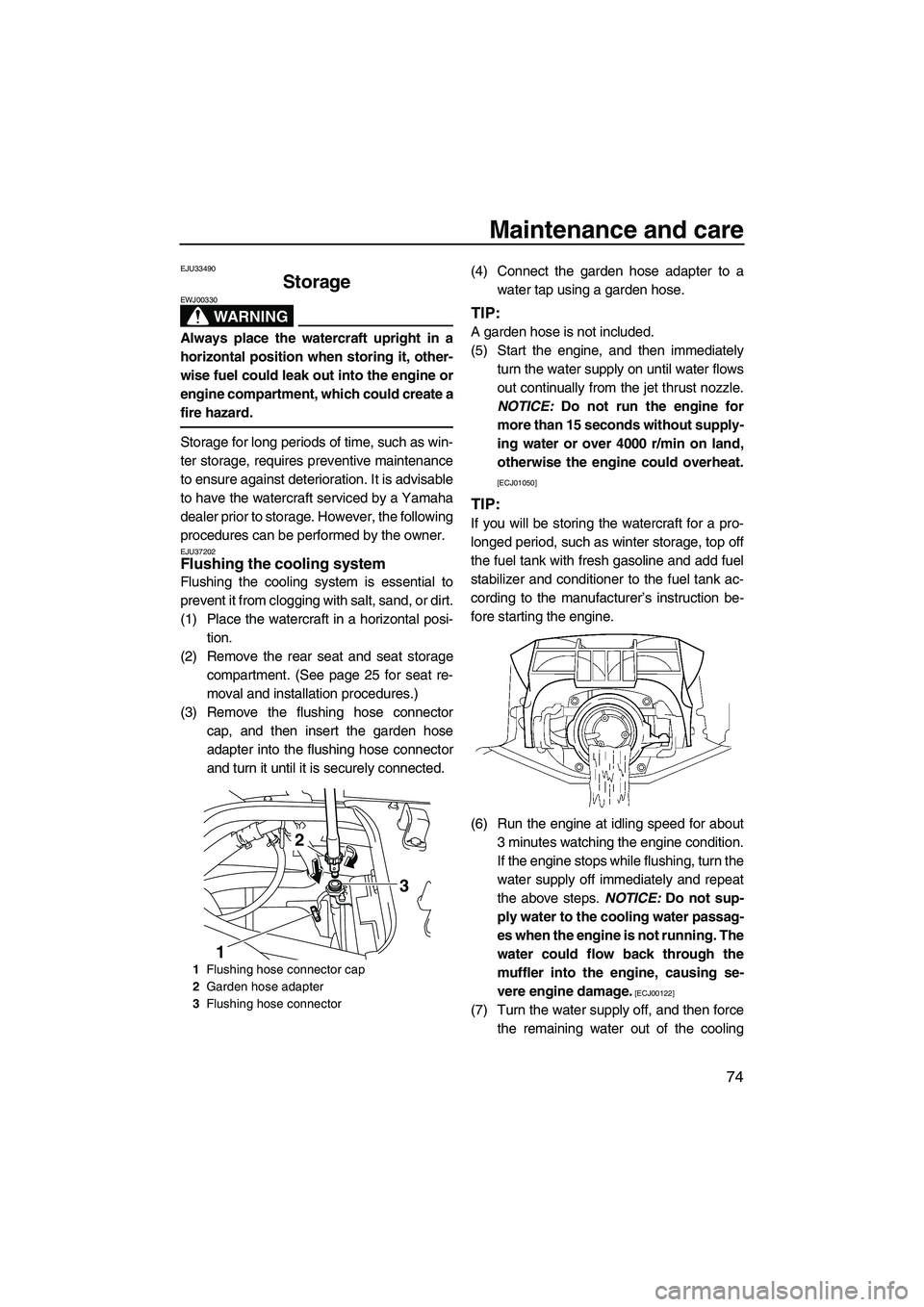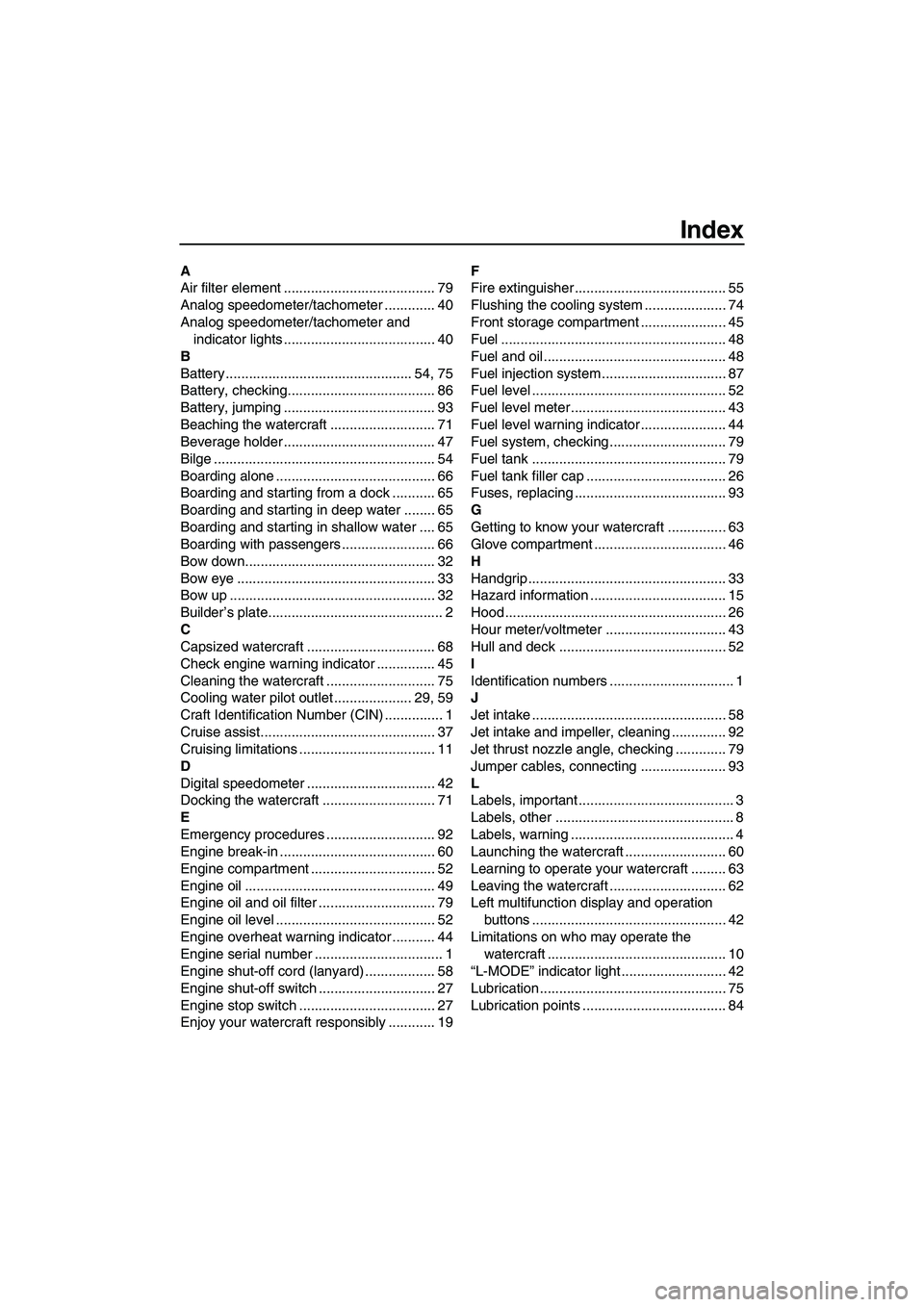2009 YAMAHA FX HO CRUISER cooling
[x] Cancel search: coolingPage 80 of 106

Operation
73
(5) Flush the cooling system to prevent it
from clogging with salt, sand, or dirt. (See
page 74 for flushing procedures.)
(6) Rinse the engine and engine compart-
ment with a small amount of water.
NOTICE: Do not use high-pressure
water when rinsing the engine or en-
gine compartment as severe engine
damage could result.
[ECJ00571]
(7) Wipe the engine and engine compart-
ment dry with a clean cloth (repeat step 3,
if necessary).
(8) Wipe the hull, handlebars, and jet unit dry
with a clean cloth.
(9) Spray a rust inhibitor on metallic parts to
minimize corrosion.
(10) Allow the engine compartment to air dry
completely before installing the seats.
EJU33462
Transporting
Before putting the watercraft on a trailer or
transporting it, be sure to put the shift lever in
the forward position. When transporting the
watercraft on a trailer, secure the tie downs to
the trailer through the bow eye and stern
eyes. NOTICE: Do not attach ropes or tie
downs to any part of the watercraft other
than the bow eye and stern eyes to secure
the watercraft to the trailer. Otherwise, the
watercraft may be damaged. Wrap the
ropes or tie downs with towels or rags
where they touch the body of the water-
craft to avoid scratches or damage. Do not
transport the watercraft with the shift lever
in the reverse position. Otherwise, the re-
verse gate may hit an obstacle, which
could cause damage.
[ECJ00642]
UF2H70E0.book Page 73 Thursday, January 15, 2009 10:49 AM
Page 81 of 106

Maintenance and care
74
EJU33490
Storage
WARNING
EWJ00330
Always place the watercraft upright in a
horizontal position when storing it, other-
wise fuel could leak out into the engine or
engine compartment, which could create a
fire hazard.
Storage for long periods of time, such as win-
ter storage, requires preventive maintenance
to ensure against deterioration. It is advisable
to have the watercraft serviced by a Yamaha
dealer prior to storage. However, the following
procedures can be performed by the owner.
EJU37202Flushing the cooling system
Flushing the cooling system is essential to
prevent it from clogging with salt, sand, or dirt.
(1) Place the watercraft in a horizontal posi-
tion.
(2) Remove the rear seat and seat storage
compartment. (See page 25 for seat re-
moval and installation procedures.)
(3) Remove the flushing hose connector
cap, and then insert the garden hose
adapter into the flushing hose connector
and turn it until it is securely connected.(4) Connect the garden hose adapter to a
water tap using a garden hose.
TIP:
A garden hose is not included.
(5) Start the engine, and then immediately
turn the water supply on until water flows
out continually from the jet thrust nozzle.
NOTICE: Do not run the engine for
more than 15 seconds without supply-
ing water or over 4000 r/min on land,
otherwise the engine could overheat.
[ECJ01050]
TIP:
If you will be storing the watercraft for a pro-
longed period, such as winter storage, top off
the fuel tank with fresh gasoline and add fuel
stabilizer and conditioner to the fuel tank ac-
cording to the manufacturer’s instruction be-
fore starting the engine.
(6) Run the engine at idling speed for about
3 minutes watching the engine condition.
If the engine stops while flushing, turn the
water supply off immediately and repeat
the above steps. NOTICE: Do not sup-
ply water to the cooling water passag-
es when the engine is not running. The
water could flow back through the
muffler into the engine, causing se-
vere engine damage.
[ECJ00122]
(7) Turn the water supply off, and then force
the remaining water out of the cooling
1Flushing hose connector cap
2Garden hose adapter
3Flushing hose connector
12
3
UF2H70E0.book Page 74 Thursday, January 15, 2009 10:49 AM
Page 84 of 106

Maintenance and care
77
EJU37060Periodic maintenance chart
The following chart gives general guidelines for periodic maintenance. However, maintenance
may need to be performed more frequently depending on your operating conditions.
This“” mark indicates maintenance that you may do yourself.
This“” mark indicates work to be done by a Yamaha dealer.
Item OperationInitial Thereafter every
Page 10
hours50
hours100
hours100
hours200
hours
6
months12
months12
months24
months
Spark plugsCheck, clean, adjust 82
Lubrication pointsLubricate 84
Internal engine
componentsLubricate*2
50 hours or 12 months—
QSTS cablesLubricate—
Intermediate hous-
ingLubricate 84
Fuel systemCheck 79
Fuel tankCheck, clean 79
Trolling speedCheck, adjust 87
Throttle shaftCheck—
Cooling water pas-
sagesFlush
*174
Water inlet strain-
erCheck, clean—
Bilge strainerClean—
Electric bilge
pump strainerCheck, clean—
ImpellerCheck—
Jet thrust nozzle
angleCheck, adjust 79
Steering masterCheck—
QSTS mechanismCheck, adjust—
Shift cable and re-
verse gateCheck, adjust 80
Throttle cableCheck, adjust 80
Stern drain plugsCheck, replace 54
UF2H70E0.book Page 77 Thursday, January 15, 2009 10:49 AM
Page 95 of 106

Specifications
88
EJU34542
Specifications
Watercraft capacity:
Maximum people on board:
3 person
Maximum load capacity:
240 kg (530 lb)
Dimensions:
Length:
3370 mm (132.7 in)
Width:
1230 mm (48.4 in)
Height:
FX High Output 1160 mm (45.7 in)
FX Cruiser High Output 1240 mm (48.8 in)
Dry weight:
FX High Output 360 kg (794 lb)
FX Cruiser High Output 365 kg (805 lb)
Performance:
Maximum output (according to ISO 8665/SAE
J1228):
132.40 kW@7600 r/min
Maximum fuel consumption:
48.6 L/h (12.8 US gal/h, 10.7 Imp.gal/h)
Cruising range at full throttle:
1.44 hour
Trolling speed:
1300 ±100 r/min
Engine:
Engine type:
Liquid cooled 4-stroke, DOHC
Number of cylinders:
4
Engine displacement:
1812 cm³
Bore & stroke:
86.0 × 78.0 mm (3.39 × 3.07 in)
Compression ratio:
11.0 : 1
Valve clearance-intake (cold):
0.14–0.23 mm (0.0055–0.0091 in)
Valve clearance-exhaust (cold):
0.28–0.37 mm (0.0110–0.0146 in)
Lubrication system:
Wet sump
Cooling system:
Water
Starting system:
ElectricIgnition system:
T.C.I.
Spark plug:
LFR6A
Spark plug gap:
0.8–0.9 mm (0.031–0.035 in)
Battery capacity:
12 V, 19.0 Ah
Charging system:
Flywheel magneto
Drive unit:
Propulsion system:
Jet pump
Jet pump type:
Axial flow, single stage
Impeller rotation:
Counterclockwise
Jet thrust nozzle angle:
24.0+24.0 °
Jet thrust nozzle trim angle:
-10, -5, 0, 5, 10 °
Fuel and oil:
Recommended fuel:
Regular unleaded gasoline
Minimum octane rating (PON):
86
Minimum octane rating (RON):
90
Recommended engine oil type SAE:
SAE 10W-30, 10W-40, 20W-40, 20W-50
Recommended engine oil grade API:
API SE,SF,SG,SH,SJ,SL
Fuel tank total capacity:
70 L (18.5 US gal, 15.4 Imp.gal)
Engine oil quantity with oil filter replacement:
3.1 L (3.28 US qt, 2.73 Imp.qt)
Engine oil quantity without oil filter replacement:
3.0 L (3.17 US qt, 2.64 Imp.qt)
Engine oil total quantity:
4.3 L (4.55 US qt, 3.78 Imp.qt)
UF2H70E0.book Page 88 Thursday, January 15, 2009 10:49 AM
Page 103 of 106

Index
A
Air filter element ....................................... 79
Analog speedometer/tachometer ............. 40
Analog speedometer/tachometer and
indicator lights ....................................... 40
B
Battery ................................................ 54, 75
Battery, checking...................................... 86
Battery, jumping ....................................... 93
Beaching the watercraft ........................... 71
Beverage holder ....................................... 47
Bilge ......................................................... 54
Boarding alone ......................................... 66
Boarding and starting from a dock ........... 65
Boarding and starting in deep water ........ 65
Boarding and starting in shallow water .... 65
Boarding with passengers ........................ 66
Bow down................................................. 32
Bow eye ................................................... 33
Bow up ..................................................... 32
Builder’s plate............................................. 2
C
Capsized watercraft ................................. 68
Check engine warning indicator ............... 45
Cleaning the watercraft ............................ 75
Cooling water pilot outlet .................... 29, 59
Craft Identification Number (CIN) ............... 1
Cruise assist............................................. 37
Cruising limitations ................................... 11
D
Digital speedometer ................................. 42
Docking the watercraft ............................. 71
E
Emergency procedures ............................ 92
Engine break-in ........................................ 60
Engine compartment ................................ 52
Engine oil ................................................. 49
Engine oil and oil filter .............................. 79
Engine oil level ......................................... 52
Engine overheat warning indicator ........... 44
Engine serial number ................................. 1
Engine shut-off cord (lanyard) .................. 58
Engine shut-off switch .............................. 27
Engine stop switch ................................... 27
Enjoy your watercraft responsibly ............ 19F
Fire extinguisher ....................................... 55
Flushing the cooling system ..................... 74
Front storage compartment ...................... 45
Fuel .......................................................... 48
Fuel and oil............................................... 48
Fuel injection system ................................ 87
Fuel level .................................................. 52
Fuel level meter ........................................ 43
Fuel level warning indicator ...................... 44
Fuel system, checking .............................. 79
Fuel tank .................................................. 79
Fuel tank filler cap .................................... 26
Fuses, replacing ....................................... 93
G
Getting to know your watercraft ............... 63
Glove compartment .................................. 46
H
Handgrip ................................................... 33
Hazard information ................................... 15
Hood ......................................................... 26
Hour meter/voltmeter ............................... 43
Hull and deck ........................................... 52
I
Identification numbers ................................ 1
J
Jet intake .................................................. 58
Jet intake and impeller, cleaning .............. 92
Jet thrust nozzle angle, checking ............. 79
Jumper cables, connecting ...................... 93
L
Labels, important ........................................ 3
Labels, other .............................................. 8
Labels, warning .......................................... 4
Launching the watercraft .......................... 60
Learning to operate your watercraft ......... 63
Leaving the watercraft .............................. 62
Left multifunction display and operation
buttons .................................................. 42
Limitations on who may operate the
watercraft .............................................. 10
“L-MODE” indicator light ........................... 42
Lubrication................................................ 75
Lubrication points ..................................... 84
UF2H70E0.book Page 1 Thursday, January 15, 2009 10:49 AM